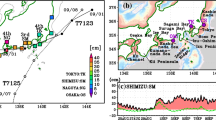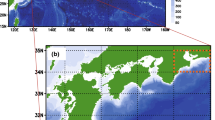Abstract
The coastal sea level propagating westward along the south coast of Japan and the impact of the disturbance on the generation of the Kuroshio small meander have been examined. The propagation occurs in sea level variations for periods shorter than 10 days and is remarkable for periods of 4–6 days. Characteristics of the 4–6 day component have been studied using the extended empirical orthogonal function (EEOF). The first and second modes of EEOF are almost in-phase throughout the south coast of Japan. The higher four modes of EEOF are significantly excited when the Kuroshio takes the non-large-meander path, and propagate westward with phase speeds of 2.8 m s−1 (third and fourth modes) and 1.6 m s−1 (fifth and sixth modes) in the Kuroshio region west of Mera in the Boso Peninsula. The analysis shows that more than 70% of the small meanders generate in two months after a significant propagating disturbance reaches south of Kyushu when the velocity of the Kuroshio is high. This effect of coastal disturbance is examined by numerical experiments with a 2.5-layer model in which coastal disturbance is excited by vertical displacement of the upper interface. The result is that offshore displacement of the Kuroshio occurs southeast of Kyushu only in the case of significant upward displacement of the interface under the influence of a high Kuroshio velocity. The significant coastal disturbance, which is associated with upward displacement of the density interface, and a high Kuroshio velocity can therefore be important factors in generating small meanders.
Similar content being viewed by others
References
Akitomo, K. and M. Kurogi (2001): Path transition of the Kuroshio due to mesoscale eddies: A two-layer, wind-driven experiment. J. Oceanogr., 57, 735–741.
Akitomo, K., T. Awaji and N. Imasato (1991): Kuroshio path variation south of Japan. 1. Barotropic inflow-outflow model. J. Geophys. Res., 96, 2549–2560.
Akitomo, K., S. Masuda and T. Awaji (1997): Kuroshio path variation south of Japan: Stability of the paths in a multiple equilibrium regime. J. Oceanogr., 53, 129–142.
Ebuchi, N. and K. Hanawa (2000): Mesoscale eddies observed by TOLEX-ADCP and TOPEX/POSEIDON altimeter in the Kuroshio recirculation region south of Japan. J. Oceanogr., 56, 43–57.
Ebuchi, N. and K. Hanawa (2001): Trajectory of mesoscale eddies in the Kuroshio recirculation region. J. Oceanogr., 57, 471–480.
Ebuchi, N. and K. Hanawa (2003): Influence of mesoscale eddies on variations of the Kuroshio path south of Japan. J. Oceanogr., 59, 25–36.
Endoh, T. and T. Hibiya (2000): Numerical study of the generation and propagation of trigger meanders of the Kuroshio south of Japan. J. Oceanogr., 56, 409–418.
Endoh, T. and T. Hibiya (2001): Numerical simulation of the transient response of the Kuroshio leading to the large meander formation south of Japan. J. Geophys. Res., 106, 26833–26850.
Holland, W. and L. Lin (1975): On the generation of the mesoscale eddies and their contribution to the oceanic general circulation. I. A preliminary numerical experiment. J. Phys. Oceanogr., 5, 642–657.
Isozaki, I. (1969): An investigation on the variations of sea level due to meteorological disturbances on the coast of the Japanese Islands (III) On the variation of daily mean sea level. J. Oceanogr. Soc. Japan, 25, 91–102.
Kawabe, M. (1980a): Sea level variations along the south coast of Japan and the large meander in the Kuroshio. J. Oceanogr. Soc. Japan, 36, 97–104.
Kawabe, M. (1980b): Sea level variations around the Nansei Islands and the large meander in the Kuroshio south of central Japan. J. Oceanogr. Soc. Japan, 36, 227–235.
Kawabe, M. (1982): Coastal trapped waves in a two-layer ocean: wave properties when the density interface intersects a sloping bottom. J. Oceanogr. Soc. Japan, 38, 115–124.
Kawabe, M. (1985): Sea level variations at the Izu Islands and typical stable paths of the Kuroshio. J. Oceanogr. Soc. Japan, 41, 307–326.
Kawabe, M. (1987): Spectral properties of sea level and time scales of Kuroshio path variations. J. Oceanogr. Soc. Japan, 43, 111–123.
Kawabe, M. (1988): Variability of Kuroshio velocity assessed from the sea-level difference between Naze and Nishinoomote. J. Oceanogr. Soc. Japan, 44, 293–304.
Kawabe, M. (1995): Variations of current path, velocity, and volume transport of the Kuroshio in relation with the large meander. J. Phys. Oceanogr., 25, 3103–3117.
Kawabe, M. (2005): Variations of the Kuroshio in the southern region of Japan: Conditions for large meander of the Kuroshio. J. Oceanogr., 61, 529–537.
Kitade, Y. and M. Matsuyama (2000): Coastal-trapped waves with several-day period caused by wind along the southeast coast of Honshu, Japan. J. Oceanogr., 56, 727–744.
Masuda, S. and K. Akitomo (2000): Effects of stratification and bottom topography on the Kuroshio path variation south of Japan. Part II: Path transitions in a multiple equilibrium regime. J. Phys. Oceanogr., 30, 1431–1449.
Masuzawa, J. (1965): Meanders of the Kuroshio—The cold water mass south of Honshu. Kagaku, 35, 588–593 (in Japanese).
Mitsudera, H., T. Waseda, Y. Yoshikawa and B. Taguchi (2001): Anticyclonic eddies and Kuroshio meander formation. Geophys. Res. Lett., 28, 2025–2028.
Moriyasu, S. (1961): On the influence of the Monsoon on the oceanographic conditions. J. Oceanogr. Soc. Japan, 17, 74–79.
Nagano, A. (2004): Characteristics of the generation and propagation of small meanders of the Kuroshio clarified by sea-level analysis. Doctoral dissertation, Graduate School of Science, The University of Tokyo, 93 pp.
Nagano, A. and M. Kawabe (2004): Monitoring of generation and propagation of the Kuroshio small meander using sea levels along the southern coast of Japan. J. Oceanogr., 60, 879–892.
Pedlosky, J. (1987): Geophysical Fluid Dynamics. Springer-Verlag, New York, 710 pp.
Shoji, D. (1961): On the variations of the daily mean sea levels along the Japanese Islands. J. Oceanogr. Soc. Japan, 17, 141–152.
Shoji, D. (1972): Time variation of the Kuroshio south of Japan. p. 217–234. In Kuroshio—Its Physical Aspects, ed. by H. Stommel and K. Yoshida, University of Tokyo Press, Tokyo.
Taft, B. (1972): Characteristics of the flow of the Kuroshio south of Japan. p. 165–216. In Kuroshio—Its Physical Aspects, ed. by H. Stommel and K. Yoshida, University of Tokyo Press, Tokyo.
Waseda, T., H. Mitsudera, B. Taguchi and Y. Yoshikawa (2002): On the eddy-Kuroshio interaction: Evolution of the mesoscale eddy. J. Geophys. Res., 107(C8), 10, 1029/2000JC000756.
Weare, B. and J. Nasstrom (1982): Examples of extended empirical orthogonal function analysis. Mon. Wea. Rev., 110, 481–485.
Yasuda, I., J.-H. Yoon and N. Suginohara (1985): Dynamics of the Kuroshio large meander—Barotropic model. J. Oceanogr. Soc. Japan, 41, 259–273.
Yoon, J.-H. and I. Yasuda (1987): Dynamics of the Kuroshio large meander: Two-layer model. J. Phys. Oceanogr., 17, 66–81.
Yoshida, S. (1961): On the variation of the Kuroshio and cold water mass off Enshu-nada (Part 1). Hydrogr. Bull., New Ser., 67, 54–57 (in Japanese with English abstract and legends).
Yoshida, S. (1964): A note on the variations of the Kuroshio during recent years. Bull. Japan. Soc. Fish. Oceanogr., 5, 66–69 (in Japanese).
Author information
Authors and Affiliations
Corresponding author
Rights and permissions
About this article
Cite this article
Nagano, A., Kawabe, M. Coastal Disturbance in Sea Level Propagating along the South Coast of Japan and Its Impact on the Kuroshio. J Oceanogr 61, 885–903 (2005). https://doi.org/10.1007/s10872-006-0007-0
Received:
Revised:
Accepted:
Issue Date:
DOI: https://doi.org/10.1007/s10872-006-0007-0




